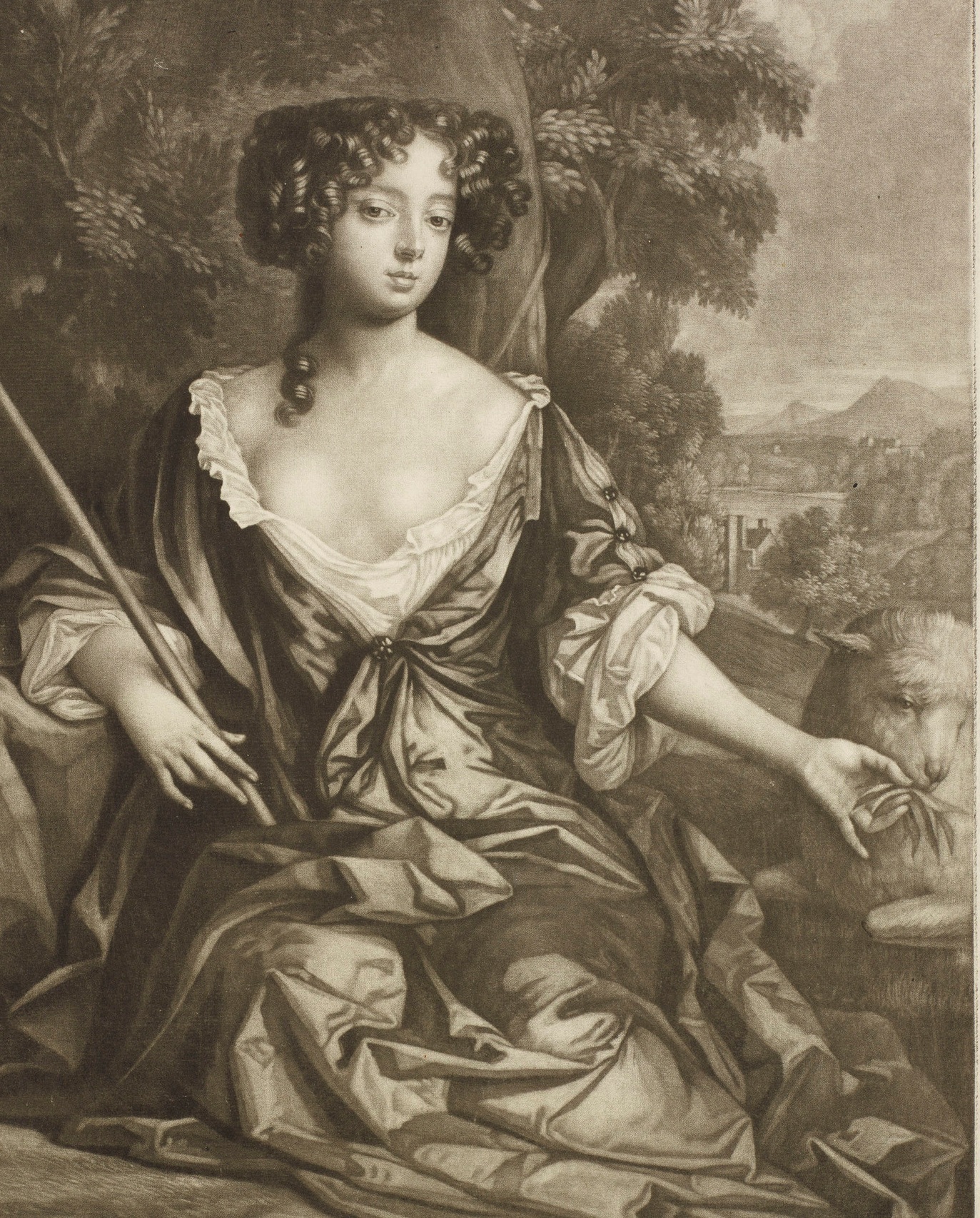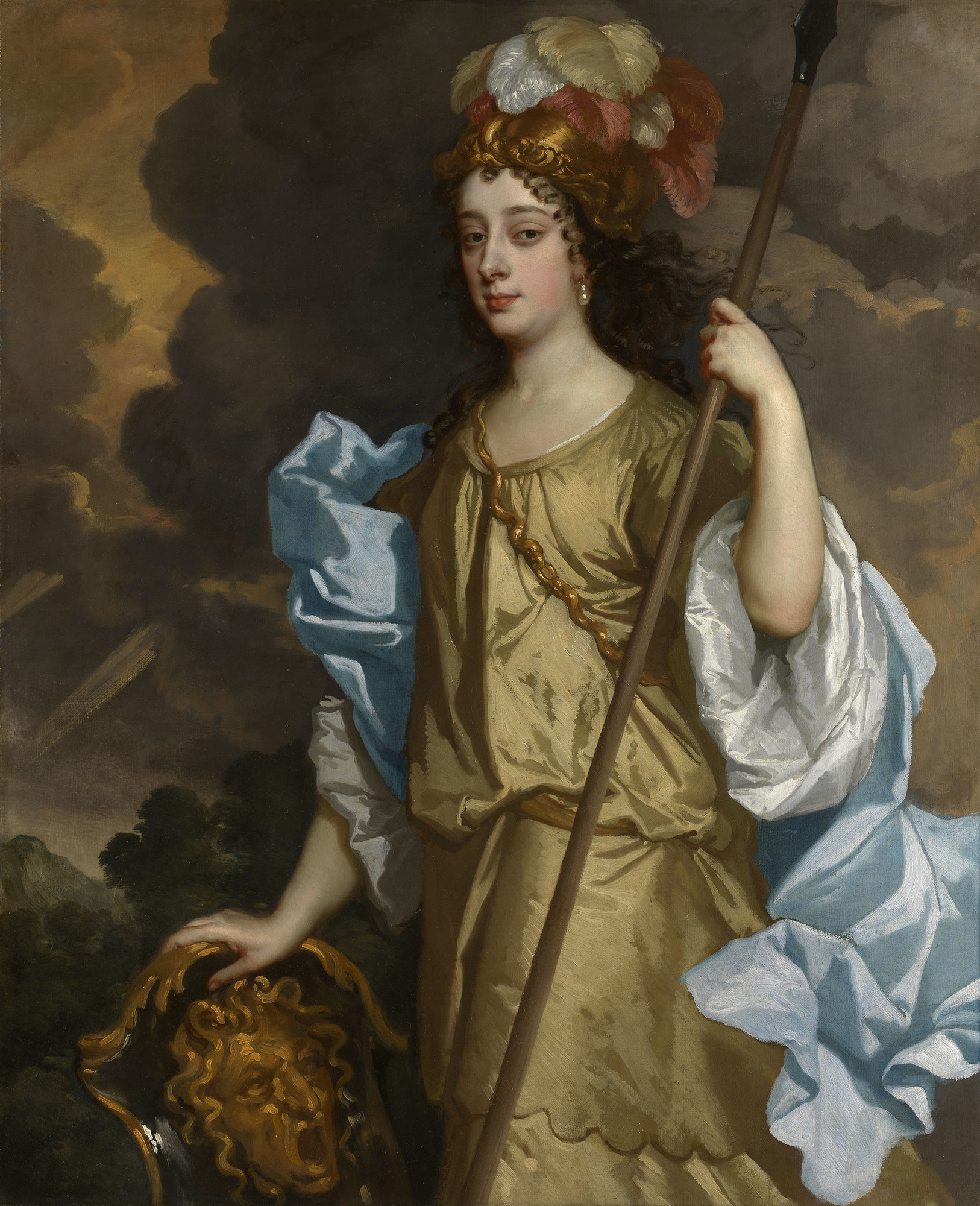Being a Royal Mistress
Having mistresses, especially for a king, had never been unusual. It was virtually expected that they would enjoy the company and pleasures of women other than their wives – marriage was for having children and securing the family line, but mistresses were for fun, sex and companionship. But it had always been understood, at least in England, that these liaisons would be somewhat private. Even if everyone at court knew that the king had a mistress, discretion was expected.
A certain Je Ne Sais Quoi…
Louis XIV, King of France, surrounded by the ladies at court,
c.1665, artist unknown.
Throughout his exile, during the English Civil War and Commonwealth, Charles spent a lot of time in France with his cousin Louis XIV and had experienced the pleasures of the French court first-hand. Louis’ court was infamous for its extravagance, hedonism, and sexual liaisons. For French monarchs, taking a maîtresse-en-titre, a chief mistress, as well as having multiple other lovers, was part and parcel of being king. A maîtresse-en-titre was actually a semi-official position at court that came with apartments, wealth, influence, and often titles and land. Children born from these relationships were also given many of the benefits of a monarch’s child (though they were exempt from the line of succession).
Once he was king, Charles adopted this custom with gusto! Not since Henry VIII had a monarch been so blatant about their infidelities. Before he had even set foot back in England, he had begun an affair with the married Barbara Palmer, who was part of the envoy sent to Europe to sail with Charles back to his crown and country. She was the first in a long line of Charles’ royal mistresses after he was declared king and, although the position of maîtresse-en-titre was never an official appointment in England, Charles II’s mistresses were in all but name the equivalent of their French counterparts.
Mezzotint portraying Louise de Kerouaille as a shepherdess. Her image was in high demand because her French style, manners and hairstyles were widely imitated.
Louise, Duchess of Portsmouth, after Sir Peter Lely, 1678
© Royal Collection Trust
Loud and Proud
So these women were not being quietly hurried up the back stairs to the king’s chambers, and their place as the king’s mistresses certainly wasn’t a secret – neither at court nor out in public. The king paraded his mistresses wherever he went: at the races, walking in London’s parks, at balls and around Whitehall palace. They were always dressed in the finest clothes, were given lavish apartments (more beautifully decorated and closer to the king’s apartments than even Queen Catherine’s), and were showered with wealth and luxuries.
In turn the mistresses made every effort to publicly display the favour that they held with Charles; showing off jewellery, leaving their own seats at the theatre to sit themselves next to the king, or flaunting their friendships with the king’s favourite courtiers (and later, his sons). These very deliberate demonstrations were designed to reinforce their position and to draw attention to the enviable place they occupied. Should anyone criticise or challenge them, they had only to remind their enemies of Charles’ esteem for them; if those courtiers wanted to get ahead with the king, they had first better appease the favoured mistress.
They were the crème-de-la-crème of high society and, whether they were loved or hated, each of them were known to virtually everyone in England and sometimes beyond. Some of his mistresses were already in the public eye, like Nell Gwyn and Moll Davis, who were successful comedy actresses. They were already breaking taboos and gathering attention from the public because the Restoration period was the first time ever that women were allowed to act on the stage. Others were aristocratic women who flaunted their relationship with the king and all the benefits that they received, whether they were already married or not.
Previously, sexuality and immorality had been linked to the lower classes, but now, the once morally superior aristocracy were seen to succumb to temptation, sex, and frivolity. Before the Restoration, extra-marital sex and adultery was considered a sin that warranted public shaming and punishments. But as the aristocracy began loosening their sexual morals - and in such a public way - much of society began enjoy the pleasures that the Restoration offered.
Here Nell Gwyn is depicted as the goddess Venus and in the engraved wording she is referred to as “Soveraigns Joy”.
Diarist,
Samuel Pepys owned a copy of this mezzotint.
Nell Gwyn as Venus, after Peter Cross c.1678-9
© Royal Collection Trust
Celebrities of the 17th Century
Suddenly there was a great deal of public interest in Charles II’s affairs with his royal mistresses and commoners alike. Like many of our modern-day celebrities, and today’s aristocratic women, images and stories of the mistresses flooded the streets of London, thanks to an expanding public sphere in which newspapers, poems, pictures and ballads could be distributed quickly and cheaply to spread the news of the elite classes. The mistresses caused a flurry of scandal and gossip throughout Charles II’s reign, and everyone from noble to commoner were talking about them.
Women, especially those from the elite circles, had never displayed and presented in such a sexualised way. We only need to take a look at some of the artwork of the mistresses that was later reproduced in engravings and prints for the public to buy, to see how these women - from actress to aristocrat - were being presented, admired, and lusted over.
They were often painted as characters from literature or mythology, perhaps for fun, but also to show their importance and place in the world. You’ll also notice in these portraits that there is a very relaxed and open style to the women, both in their physical body language, and in their clothes, which are free flowing to expose their shoulders, necks, cleavage and breasts. Or, in the case of this mezzotint of Nell Gwyn as Venus… completely naked!
In a way this publicly accessible artwork created a sort of bond between Charles II and his subjects as desirers of the same women and may even have helped in his popularity with the public.
Duchess of Cleveland as Minerva, Roman goddess of war and wisdom, which was copied to Mezzotint for distribution.
Part of the 'Windsor Beauties' series by Sir Peter Lely.
Barbara Villiers, Duchess of Cleveland by Sir Peter Lely c. 1663-65
© Royal Collection Trust
Not just a pretty face
Sure, these women were beautiful, fun and sexy, but a few of them – notoriously Barbara Palmer and Louise de Kérouaille - were often at the centre of the political goings-on at court.
In France, little was thought of using women in the political landscape, and they were much more likely to act as intermediaries in negotiations than their counterparts in England. However, Charles’ draw to female company, and his recognition of their ability to be just as capable and intelligent as his male courtiers when it came to acting as emissaries, meant that he too began to involve the women closest to him in politics.
The mistresses often used their closeness to the king to further their own political beliefs, or the agendas of their family and friends - not to mention the fact that they could be dangerous opponents to anyone who had crossed them. Sometimes referred to as the gatekeepers of the king, they not only had Charles’ affections, and his ear, but at times they could even control who could socialise with him. Grand parties were held in their chambers that everyone at court scrambled to be invited to – but they were the ones in control of the guest list. Even foreign ambassadors, who recognised their importance, attempted to cultivate friendships with them and earn their trust in order to deal with Charles more closely.
They also had access to the king during the moments of quiet intimacy; chatting over supper, lying in bed in the morning, or when the king sought solace and privacy in their chambers, away from the demands of kingship. This was a relationship that male courtiers could never hope to have.
But their power shouldn’t be over-estimated. Anyone who believed that Charles could be persuaded to do anything he did not already want to do would be sadly mistaken. The mistresses close position to the king was also often abused by courtiers who ‘sided’ with them and manipulated them for their own gain as much as the women themselves could use it to their own advantage. The politics at court were ruthless and personal, and everyone was jostling for their place at the king’s side.
In this 1682 satirical verse, the ghost of Jane Shore - Edward IV’s infamous and doomed mistress who was made to pay public penance and thrown in prison after his death - threatens the duchesses Cleveland and Portsmouth about the perils of being a public and hated ‘whore’ to a king.
“See what I am, I was once such as you
I was a whore a Royal Mistress too.
-
You two great Women great in lust and sin
Repent, repent, and to reform begin,
For your reward you Hell at last will win”
Controversy at Court
Of course, not every was happy with the mistress’ positions at the king’s side.
As the shine of the re-established monarchy began to wear off, and more attention was payed to the true role of these women, people increasingly voiced concerns about the influence that the mistresses - especially Barbara Palmer and Louise de Kérouaille - had over the king. Even those who openly admired the mistress’ beauty, wit, and intelligence, like Samuel Pepys, worried that they were distracting Charles from important matters of state and clouding his judgement when it came to international disputes.
Charles’ advisers and ministers lamented the political power they held, and hated that they so often trumped the men at court when it came to influencing the king’s decision making. Sometimes they could work the women to their advantage, but more often than not, they viewed them as dangerous and manipulative foes.
As well as the courtiers, many members of the public, religious groups, and political factions were sick of the mistresses. Whether they disliked the immorality of Charles’ relationships with them, the sheer expense that it cost for these women and their illegitimate children to be well kept, or the religious or political stances they clearly took (especially in the case of Louise) there were cried for Charles to dismiss his lovers.
But whatever opinion people had of the mistresses, the fact was, they were there to stay! Charles’ favourite courtesans may have come and gone at his own whim, but he did not give in to pressure to move them from the palace, spend less time with them, stop indulging their political agendas, or cut funding to them and their children. Rightly or wrongly, the royal mistresses influenced the workings of court, country, and foreign policy.




